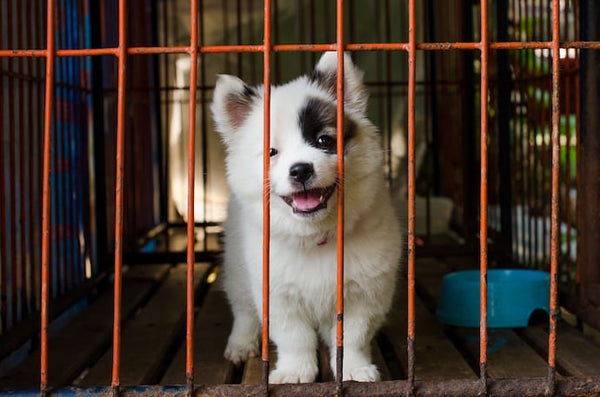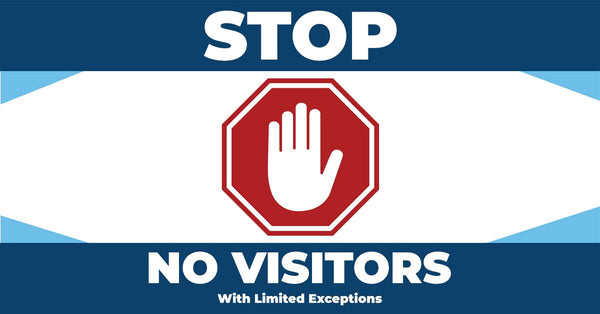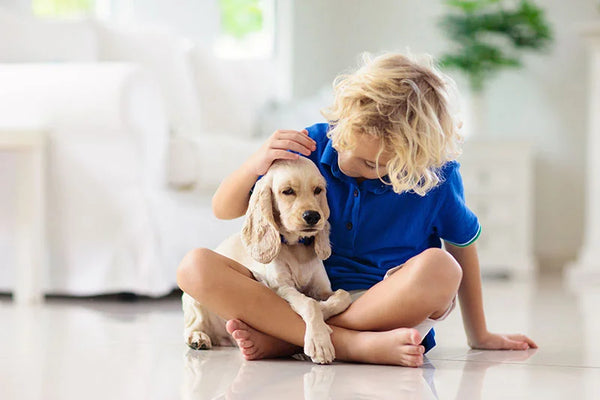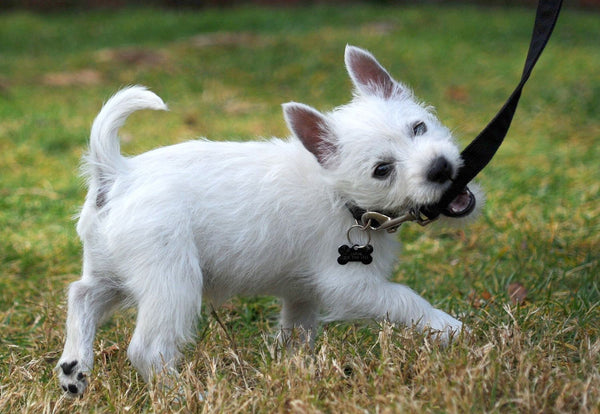We bet you’re super excited about your new puppy! We want you to have a successful first week home with your new puppy. If you haven’t brought your new puppy home just yet, here are the tips:
Make sure you bring your new puppy home in a crate.
We know you’ll be tempted to keep them on your lap on the way home but you’re missing one of the very first opportunities to work on crate training with your puppy and we want to keep your pup safe on the car ride home,.
Trust us if you want the first night to go smooth, you’ll heed the advice and start crate training asap!

You’ll want to set up a few things prior to pup’s arrival or if you just brought
pup home, set these things up now.
#1 Puppy pen inside for play, you can learn more about what to put in the puppy pen here, and what to put under it so accidents don’t ruin your floors
#2 A puppy pen outside, this is where you’re going to take your pup to potty outside.We use a puppy pen when pups don’t have all vaccinations and we don’t want them to eat things on the ground.
#3 Set your crate up in a semi-quiet place and get something bigger to put on top of the crate this way when you put the sheet or blanket on top, puppy won’t pull it in and chew on it.

When you arrive home you are going to take your puppy to the potty spot before you even enter the home. Reward your puppy outside in the potty spot, not when they come back in…We only recommend you stay outside for about 10 minutes tops not any longer, this gives pup a chance to play or lose focus when they should going potty Inside your home… make sure you give your pup access to one room right now. Since you’re already working on potty training from the minute you bring your puppy home you’re going to want to keep pup in one room right now. Your pup is given access to more space when they can be trusted and for most pups this is about a month away. We give access to one room at a time so as not to overwhelm pup and set pup up to have more accidents inside. You can use a puppy pen inside if you have a more open floor plan. Now you’re going to want to follow a pretty tight schedule at least for the first week or so as your puppy adjusts to their new home.

During this first week, you’re going to want to limit visitors or extra excitement for your pup because they are already taking in so much in such a short amount of time
leaving litter and mother or rescue group… new home, new routines, new schedule, new people, new everything. Wait about a week to introduce your puppy to people outside your home.

If you’re introducing a new puppy to kids… advise all kids to be calm, quiet, and to sit in a chair upon first meeting the puppy.Kids sitting on the floor tend to want to grab the puppy, hug, kiss, and overwhelm puppy too fast. Once pup is feeling more comfortable and confident, have one child at a time, move to the floor, not all at once.
Let pup come to them, have kids remain calm and quiet, no fast movements.
Dogs are drawn to movement and may think kids are playing so puppy may nip or bite thinking this is what they are supposed to do.

Whether you’re taking pup out to potty, walking them around the house or meeting new people… make sure they are on a leash. One of the skills you’ll be working on during week one is leash skills. Many pups panic when a collar and leash are first introduced. We want to make collar and leash a positive experience and use them often as these are skills they will need for years to come. We see all too often new puppy owners letting their pups roam free outside to potty or walk around the yard because they say the pup freaks out when they collar and leash get put on.Teaching pup early on to wear these will help training go much smoother.Pup will stay more focused on the task at hand instead of take off.

Now during week 1 you’ll also be working on something trainers call impulse control This means your puppy will learn to control their excitement or behavior and things before they react.This isn’t a skill a puppy knows right away, it has to be taught to them.This is the difference between a puppy who knows how to politely sit to say hi vs one that jumps all over everyone to say hi. One puppy knows impulse control and manners and the other doesn’t.

During week one you will also be working on Name Game with your puppy,
This means you will be teaching your puppy their name means tune in to you when you call it.For this reason we don’t ever want to use our dog’s name in low corrective tones.We want our pups to want to tune in, not tune us out.
We use a firm eh-eh when we need to stop our pup from doing something we don’t like, such as chewing on a shoe or furniture. Anytime you correct your pup using the eh-eh, you have to redirect them to what you want them to be doing instead. Keep in mind your puppy wasn’t born knowing what words mean so you shouldn’t be saying things like come here, come on, leave it, quiet, knock it off, stay, If you ask for these words before you’re puppy actually knows what they mean… you’ll likely teach them the wrong word association. This means if your puppy is barking and you say “quiet” (and they don’t really know what quiet means) you’re going to teach them the word quiet means keep barking. Because you’re airing the word quiet with their barking.
Pup has to stop barking first and then we can pair that silence with the word quiet. Later down the road it becomes the command quiet in which our pup can then stop barking.Now this same word association concept is applied to every single word or eventual command you want your puppy to know and follow.

Now the last tip I want to share with you is be prepared for barking, crying, biting and accidents. We think new puppy owners underestimate how much new puppies are like brand new babies.And if your puppy is a baby shark, which most are… and your pup wants to bite you and the rest of the family…You’ll discover that puppies are drawn to movement and your hands and feet are easy targets because they move a lot.You’ll want to make sure your puppy is not overtired which leads to extra biting and doesn’t have a ton of pent up energy which also leads to more biting.
